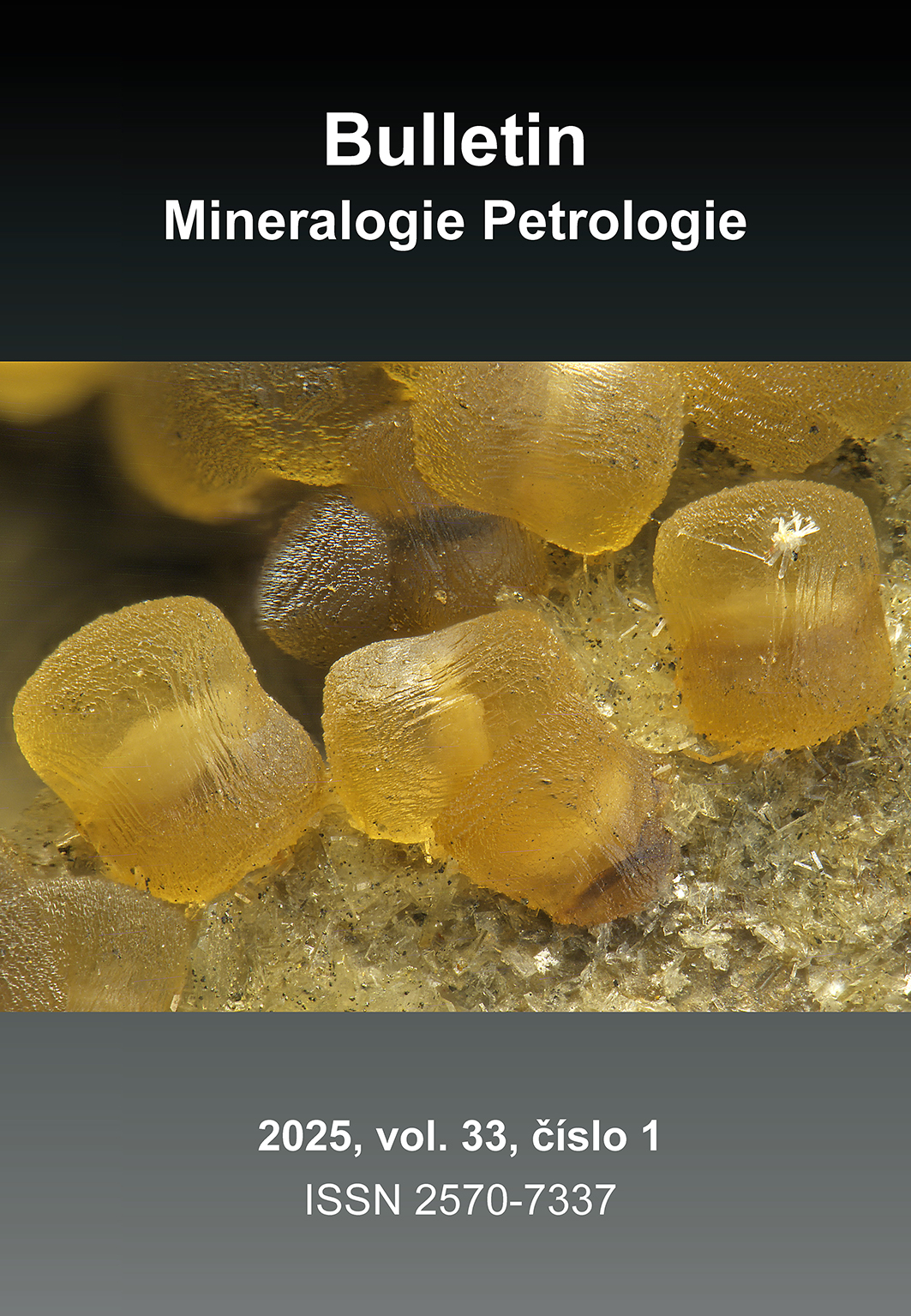Charakteristika měděného slitku ze zlatého dolu na Zlatém vrchu v Mníšku pod Brdy (střední Čechy, Česká republika)
Characterization of a copper pig from a gold mine at Zlatý vrch Hill in Mníšek pod Brdy (central Bohemia, Czech Republic)
Klíčová slova
Abstrakt
A copper pig with dimensions 3.3 × 2.3 × 1.7 cm and weighing 25 g was found together with few iron artefacts (several mining chisels, several fragments of mining hoes, a hook) in dump material of ancient gold mine at the Zlatý vrch Hill near Mníšek pod Brdy town, central Bohemia, Czech Republic. The gold mines were in operation in the surrounding area in the 15-16th centuries with some later attempts in 18th century. A material characterization of the copper artefact, based on reflected light microscopy and electron microprobe study, is presented in this paper. The composition can be roughly approximated as an As-poor Cu-As alloy, with predominating matrix composed of low-As copper and most impurities being concentrated in intergranular spaces of low-As copper grains, where domeykite and inclusions of native lead were identified. The copper matrix contains 1.54 - 2.23 wt. % As, and low Sb and Ni. Strongly substituted domeykite (Cu3As) contains high Sb (9.3 - 15.6 wt. %) and lesser amounts of Pb, Ni, S, Ag, Sn, and Fe. Metallic lead is characterized by elevated contents of Bi, Ag, Sb, Cl, and S. In addition, a discontinuous rim with composition close to cuprite (Cu2O), locally containing inclusions of a Sb-As oxide, was identified on the surface of the copper pig. The element assemblage observed in the studied metallic artefact may indicate the source of the copper ore in the neighbouring base-metal (Ag-Pb-Zn) Příbram ore area, however, there are not known indications of historical smelting of sporadically occurring copper ores in the Příbram area. Therefore, we suggest that the studied artefact likely has more distal provenance.
Soubory
Reference
Barvíř JL (1903) Výskyt zlata u Mníšku. Horn hutn listy 4(4): 59-60
Li L, Xu M, Li Q (2022) Arsenic pre-removal from antimony oxide powder by roasting with pyrite (FeS2) for decreasing arsenic transfer and pollution in the followed antimony smelting process. Sep Sci Technol 57: 1978-1991. https://doi.org/10.1080/01496395.2021.2020290
Litochleb J, Černý P, Sejkora J, Šreinová B, Korba M (2012) Ložiska a výskyty nerostných surovin na území brdských Hřebenů a v jejich okolí (střední Čechy). Bull mineral-petrolog Odd Nár Muz 20(2): 129-176.
McKerrell H, Tylecote RF (1972) The working of copper-arsenic alloys in the Early Bronze Age and the effect on the determination of provenance. Proc Prehistor Soc 38: 209-218. https://doi.org/10.1017/s0079497x00012111
Mezileský JN (1853) Ještě něco o Mníšku. Lumír 41: 976-980
Mödlinger M (2023) Structures and phase equilibria in the ternary Cu-As-Sb system. MS, Ph.D. thesis, Università degli Studi di Genova, 53 pp.
Mödlinger M, Sabatini B (2016): A re-evaluation of inverse segregation in prehistoric As-Cu objects. J Archaeol Sci 74: 60-74. https://doi.org/10.1016/j.jas.2016.08.005
Mödlinger M, De Oro Calderon R, Haubner R (2019) Arsenic loss during metallurgical processing of arsenical bronze. Archaeol Anthropolog Sci 11(1): 133-140. https://doi.org/10.1007/s12520-017-0534-1
Pouchou J, Pichoir F (1985) „PAP“ (jrZ) procedure for improved quantitative microanalysis. In: Armstrong JT (ed): Microbeam Analysis: 104-106. San Francisco Press. San Francisco
Roberts EJ, Fenwick F (1928) The antimony-antimony trioxide electrode and its use as a measure of acidity. J Amer Chem Soc 50: 2125-2147. https://doi.org/10.1021/ja01395a010
Sabatini B (2015) The As-Cu-Ni system: a chemical thermodynamic model for ancient recycling. J Miner Metal Mater Soc 67(12): 2984-2992. https://doi.org/10.1007/s11837-015-1593-3
Subramanian BR, Laughlin DE (1989) The As-Cu (Arsenic-Copper) system. Bull Phase Diagr 9(5): 605-617
Šťastný J (1948) Městečko pod Skalkou. J Šťastný, Řevnice 1-348
